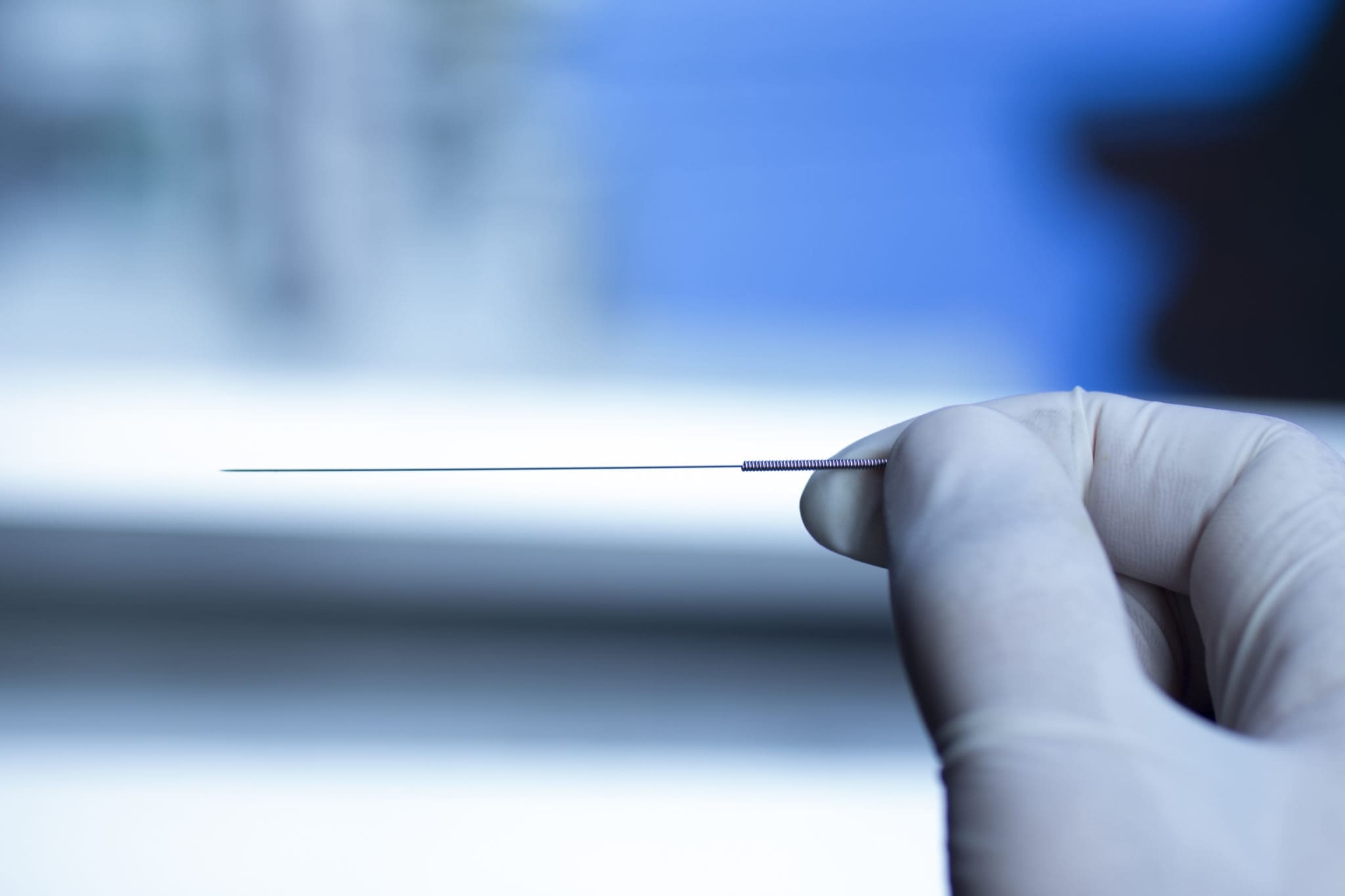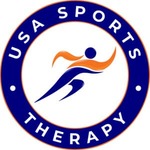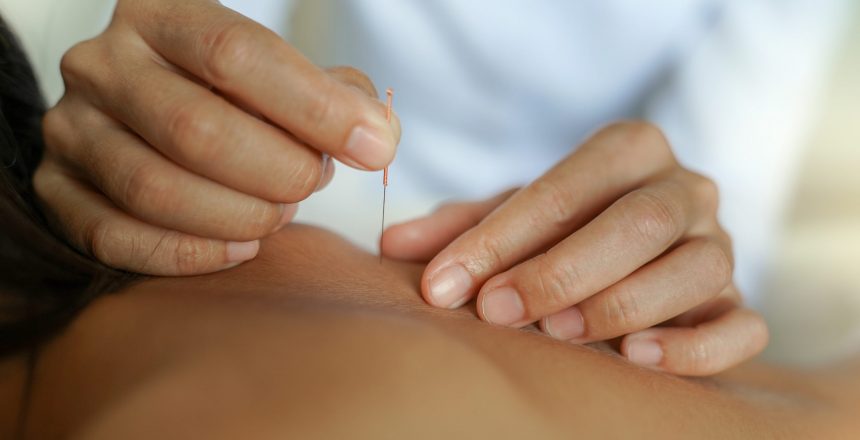You have probably heard about acupuncture, but another practice called dry needling has recently gained popularity. Knowing the difference between dry needling and acupuncture can help you figure out the type of treatment that is right for you.
The Similarities
If you are looking at a picture, dry needling and acupuncture look alike. In fact, you probably will not be able to tell which is which unless you are knowledgeable about both methods. Both acupuncture and dry needling involve using thin, stainless steel needles inserted into the skin to treat pain.
However, this is where the similarities end.
A Bit About Acupuncture

In case you are unfamiliar with acupuncture, here are a few things to keep in mind.
- The History of Acupuncture: Acupuncture is part of traditional Chinese medicine and has been used for centuries to treat various ailments. The first mention of acupuncture dates back to 100 B.C.E. in The Yellow Emperor’s Classic of Internal Medicine; however, evidence suggests that needles and, before that, bones have been used as early as 6000 B.C.E.
- How Acupuncture Works: Acupuncture is based on the idea that the human body has over 2,000 acupuncture points connected by pathways known as meridians, where Qi, or life force, travels. By inserting the needles at specific points, the acupuncturist helps promote the proper flow of Qi, which promotes overall wellbeing.
What Does Acupuncture Treat?
Acupuncture has been applied to remedy a wide variety of ailments, including dental pain and sciatica. While modern research is only beginning to understand the full extent of how acupuncture works, studies have shown that acupuncture has a significant effect on chronic aches and pains, such as lower back pain, knee pain, and even migraines.
What Is Dry Needling?
Unlike acupuncture, dry needling has developed over the past couple of decades, intending to relieve muscle pain, increase tendon healing, and reduce fascia restrictions. Like acupuncture, dry needling is done by inserting several needles under the skin. Unlike some needles that are used to inject a liquid, these needles are simply inserted at specific “trigger points” in the muscle or tissue, thus the term “dry” needling.
How Dry Needling Works
The other term for dry needling is “intramuscular stimulation” because the needles are inserted into the hard or knotted muscle. The idea is that needles when inserted appropriately by a trained practitioner for a short amount of time, will help relieve knots, muscle pain, and even muscle spasms. There are several types of dry needling techniques, including:
- Pistoning: This is also called sparrow pecking. This technique relies on swift needle insertion and removal, which means that the needles do not stay in the skin for long. The idea is that a brief prick of the needle on the trigger points will relax the muscle. While this technique is gaining popularity, more research is needed to support its efficacy.
- Non-Trigger Point Technique: This technique aims to target more than just the central nervous system. Instead, needles are inserted in areas around the point of pain or the non-trigger point. The technique is designed based on the idea that nerve and muscle tissue around the painful area can also contribute to the problem- even if the pain is not felt in that particular spot.
What Does Dry Needling Do?
Dry needling is thought to provide relief for certain types of muscular pain and stiffness while also improving flexibility and range of motion. Dry needling is often used to treat muscle pain, sports injuries, and fibromyalgia pain.
Evidence for Dry Needling
Because dry needling is a relatively recent technique, research is currently underway to explore its potential benefits and prove its efficacy. However, preliminary results have allowed dry needling to become a method that licensed, knowledgeable practitioners can currently use to treat certain ailments.
For instance, physical therapists may recommend dry needling as part of their treatment plan for certain injuries.
What Are the Side Effects of Acupuncture and Dry Needling?
Any treatment has the potential for side effects. Acupuncture and dry needling have similar potential side effects, with some differences:
- Dry Needling: Common side effects for dry needling are very mild and include bruising, bleeding, and temporary soreness at the insertion site.
Other potentially more serious side effects are rare and are often the result of poor training or negligence. For instance, if the needles used for dry needling are not properly sterilized between patients, there is a risk of infection and blood-borne illness transmission.
- Acupuncture: Common side effects of acupuncture are typically mild and include bruising, bleeding, and temporary soreness at the insertion site. As with dry needling, there is also a danger from poorly sterilized needles. In rare cases, an acupuncture needle may break and damage an internal organ.
However, the above risks are significantly decreased when acupuncture is performed correctly by a trained professional.
Who Does Acupuncture?
The National Certification Commission licenses acupuncturists in the U.S. in Acupuncture and Oriental Medicine. Most states recognize this board, and practitioners licensed by this board must prove their skills via extensive training and practice.
Who Does Dry Needling?
While there is not much regulation on who can and who cannot do dry needling, it is recommended that the procedure be performed by a trained and licensed professional. While the risks of dry needling are low, they increase significantly if the person performing the procedure is not properly trained.
In some cases, certain places like USA Sports Therapy will offer both acupuncture and dry needling.
Cost Comparison:
Cost can be a significant factor when debating between two different ways to get care. Here are the breakdowns:
Acupuncture Cost
A typical acupuncture consultation will cost up to $95. In some cases, insurance may cover the cost. However, we recommend checking with your individual insurance plan about coverage.
Dry Needling Cost
Dry needling sessions run around $40 per session in addition to the cost of the appointment, which depends on where you are getting the procedure. For instance, if you are doing dry needling as a part of physical therapy, there may be other associated therapies and costs.
Takeaways
- While dry needling and acupuncture seem similar, they are, in fact, very different.
- Acupuncture has been shown to treat a variety of chronic pain conditions, whereas dry needling is more focused on muscle and ligament pain.
- Whichever procedure you choose, make sure that you are being treated by a licensed professional.

